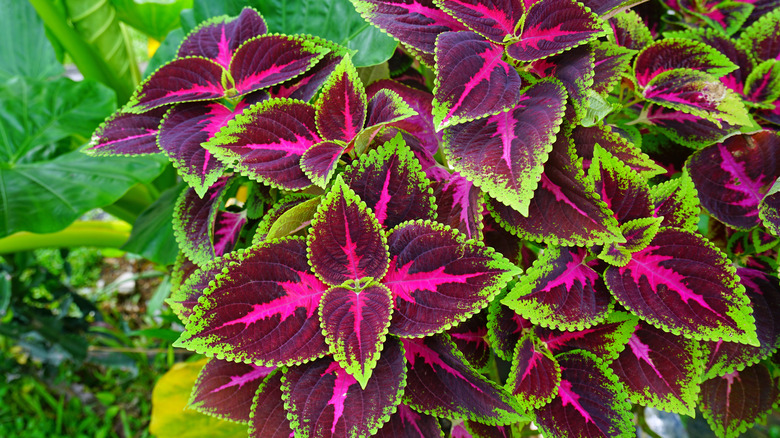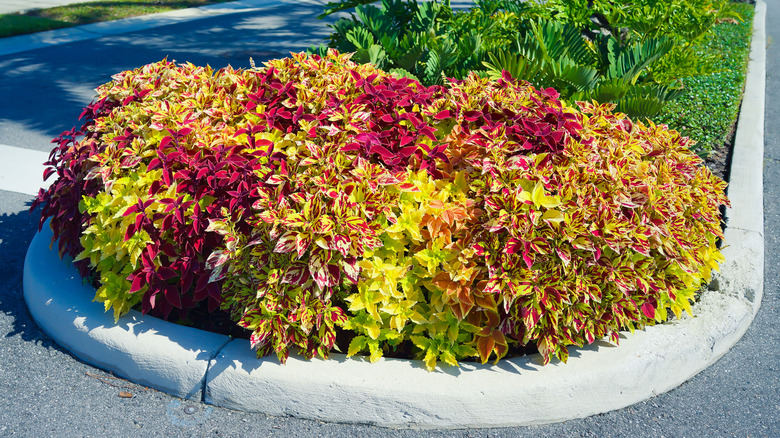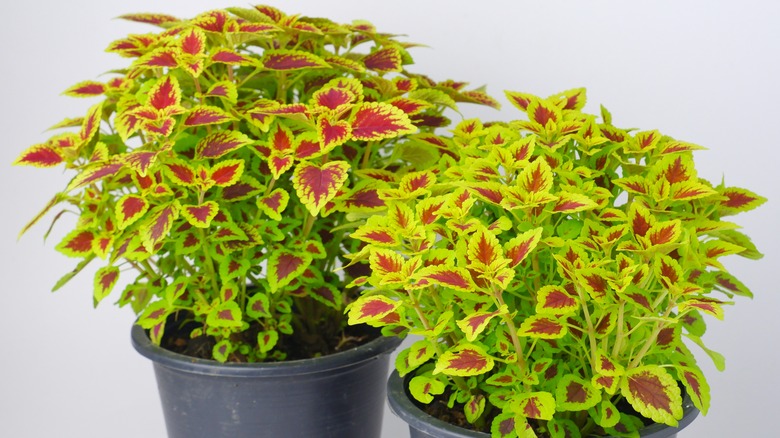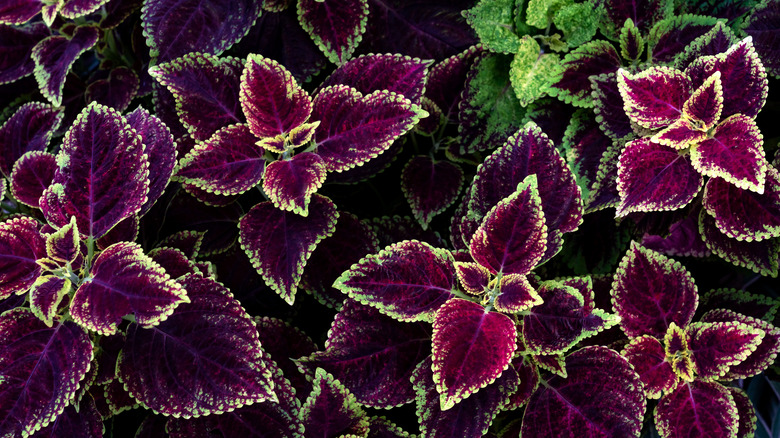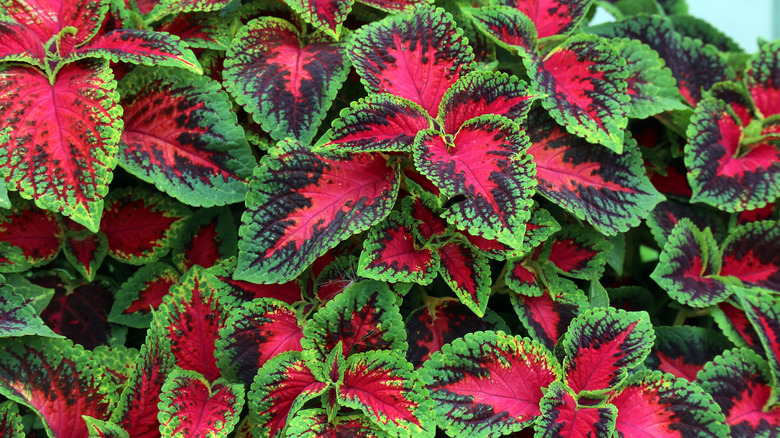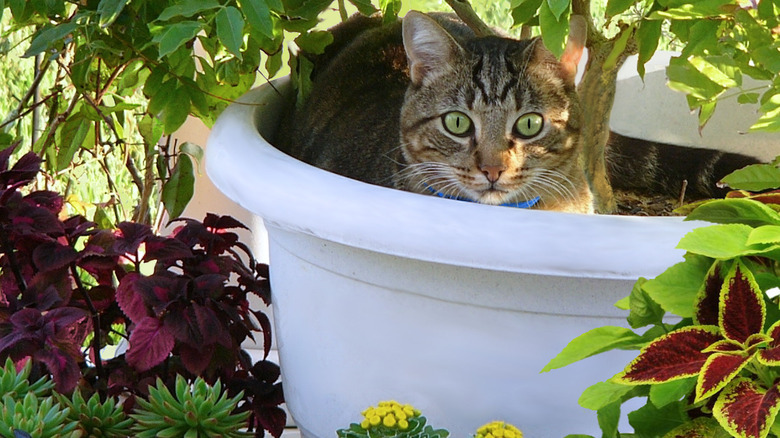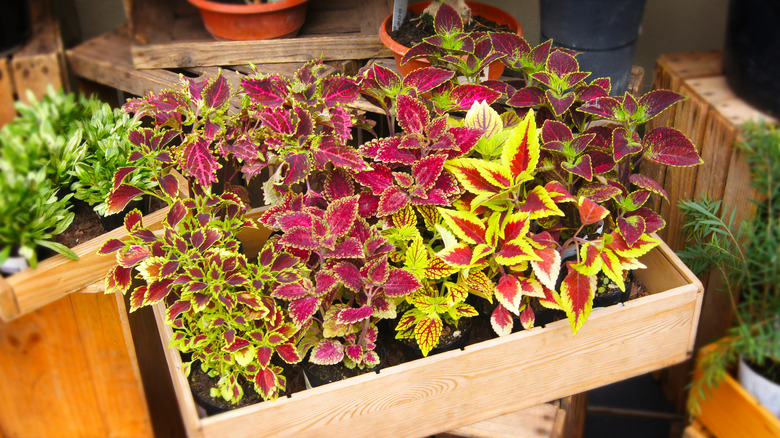How To Grow And Care For Coleus Plants
The coleus genus refers to a group of perennial herbs and shrubs that make wonderful container and bedding plants. The most popular species within this genus to grow is the coleus scutellarioides, simply known as coleus. It is a bushy plant with square-shaped stems and leaves. Coleus plants can be found in a variety of colors from deep burgundy to creamy white.
According to The Spruce, the plant is native to Australia and Southeast Asia. Yet, it can be found growing outdoors in a few other places that are within USDA hardiness zones 10 and 11. This includes the southernmost tips of Texas, California, Florida, and Arizona, as well as the entire state of Hawaii. Because Coleus needs very warm weather to survive outdoors, it is often grown as an indoor houseplant. As a houseplant, it takes little effort to grow, making it a great plant for beginner and expert gardeners alike.
How to use coleus plants in garden
Coleus plants are great bedding plants if you live in one of the warmer states. They can grow as perennials with very little care. When living in a colder state, coleus can still be grown outdoors in window boxes, hanging gardens, and outdoor containers as annuals, as per Gardener's Path. Because they come in such a wide range of colors, many gardeners choose a few different varieties to use together in the same container or section of the garden.
There are many ways to use coleus in the garden. Since most cultivars are not sun-loving plants, they welcome the opportunity to liven up the shadiest areas of your outdoor landscape. Try placing them at the base of trees, in dark corners of your garden bed, or hanging baskets shaded by your porch. They make great accent plants when you match their leaves to similarly colored flowers in your garden, or you can plant large sections of them for a dramatic look.
How to grow coleus plants
Before growing a coleus plant, you will need a rich, well-draining potting mix and a self-draining pot if you are growing it as a houseplant. While coleus love to stay in moist soil, you will not want yours to sit in excess water as that can quickly lead to root rot.
To grow coleus, you can choose from two methods: growing from seeds or growing from propagation. When growing from a seed, you should plant coleus indoors in the spring roughly eight weeks before the last frost date, as told by Gardening Know How. To start, fill a shallow tray with potting mix and sprinkle your seeds all over it. Then, place a thin layer of soil over the top. Cover your tray with plastic wrap to create a greenhouse effect and place it in a warm, sunny part of your home. After the seeds sprout, uncover the tray and wait for the seedlings to grow large enough to be transplanted.
Propagating coleus plants through cuttings is even easier. As explained by The Spruce, you can begin by cutting off a stem of at least 4 inches with scissors beneath a leaf node. Then remove all the leaves on the stem's lower half. After dipping the cut end of the stem into a rooting hormone, you can place it into a small pot of soil. Once three weeks have passed, it should develop a small but healthy root system.
How to care for coleus plants
Coleus are great indoor and outdoor plants to grow for gardeners of all experience levels. However, they do need specific conditions to survive for long periods of time. They need nutritious soil supplemented with compost or perlite to ensure excess water will drain out properly. You'll also want to make sure they have access to a humid environment. While they can't tolerate sitting in water, according to Gardener's Path, they do need their soil to be consistently warm and moist.
Before planting your coleus plant, you should pick out a sufficiently shady area for them to live in. They thrive in part-shade to full-shade areas, unless you've found one of the newer coleus varieties that have been bred to enjoy the sun. Indoors, you should find an area within your home where your coleus can enjoy some indirect sunlight in the morning and afternoon. When watering indoor or outdoor coleus plants, you should make sure that their soil is never fully dry. Sticking to a daily watering schedule will help your plant get the hydration it needs. Keep a close eye on your coleus during the hot summer months. During this time, it may need to be watered twice per day, as told by The Spruce. Additionally, you shouldn't need to fertilize this plant often, especially if it was planted in rich soil outdoors. As a houseplant, you may give it an all-purpose diluted fertilizer once per month to help it grow.
Coleus varieties
All Coleus plants are native to southeastern Asia and Australia, as well as to some parts of India and Africa. Yet, many of its varieties were created by victorian-era botanists, hybridists, and hobbyists during the "The Great Coleus Race," as explained by Rosy Dawn Gardens. Now, there are nearly 300 species of Coleus and plenty of varieties between them. The following is a list of some of the most popular varieties of coleus today.
-
Wizard Series: This variation of coleus is known to withstand direct sunlight, though it still doesn't appreciate it all the time. They are smaller than most coleus plants only growing to about 1 foot tall.
-
Fairway Series: These are even smaller than the wizard series, growing less than 8 inches tall in adulthood. They are great container plants.
-
Premium Sun Series: As their name suggests, this variety of coleus was bred to tolerate sunlight more than any other.
-
Black Dragon: This plant is quite unusual within the coleus genus; it has ruffled edges and dark pink leaves. It grows to an average height of 18 inches.
-
Chocolate Mint: Named for its leaves with a deep brown center and light green edging, the chocolate mint variety is a bushy, herb-like plant that can grow as tall as 20 inches.
-
Watermelon: Part of the premium sun series, this variety features leaves with a bright pink center and green edges. Its red veins contribute to its watermelon-like image.
Are coleus plants toxic?
The coleus plant is very toxic to pets including cats, dogs, and horses, as described by the ASPCA. If ingested, it can cause diarrhea, vomiting, drooling, mouth irritation, and sometimes bloody stool or urine due to its essential oils. You should keep your pets far away from this plant as it can cause skin irritation and burns simply from being brushed up against. If you suspect that your pet has eaten or touched the leaves of a coleus plant, you should immediately seek veterinary attention.
Fortunately, the plant is unlikely to cause adverse reactions for humans. Yet, if you have children in your home with you, you should keep an eye on them around this plant. It is possible for an allergic reaction to occur after touching its leaves which contain essential oils. Even though it is part of the same family as mint, oregano, and thyme, it should not be eaten as an herb.
How to repot coleus plants
To repot your coleus plant, start by gathering some tools and materials. You'll need a rich, loose, well-draining potting mix, a self-draining container, and possibly a flat tool for unpotting. According to Gardener's Path, your pot should be larger than 8 inches tall and wide if you are repotting a mature plant. Repotting, as with most plants, should be done during the spring or summer. Coleus only need repotting about once per year or once every two years depending on its size.
When you are ready to begin the repotting process, start by removing your coleus from its original pot using a flat tool such as a butter knife if it is stuck. Once out of its pot, gently tease out the excess soil to expose its roots. Find your new pot and place the plant within it, packing the soil on top of its roots to secure it. Finally, you should water it generously before placing it in a shady area to continue growing.
